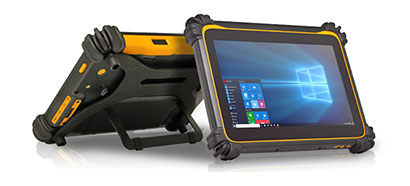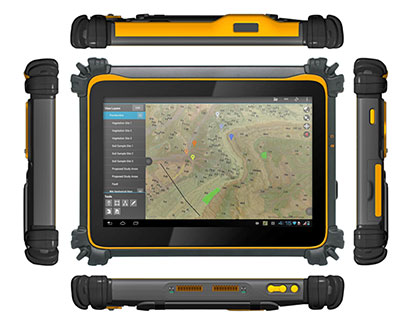|
DT Research DT395CR
Rugged, purpose-built 8.9-inch tablet computing solution that even accountants will love
(by Conrad H. Blickenstorfer)
Share on:




On September 19, 2016, DT Research announced the DT395GS rugged tablet computer with a very specific goal: to provide a competent, versatile and purpose-built vertical market computing solution that costs less than consumer-grade tablets over the lifetime of the deployment.

The big picture here is this: A lot of jobs out there require tablets that are tough and don't break. There are tough tablets out there, but most cost a fortune. So some customers buy cheap consumer products, but then those break. DT Research claims to offer a rugged tablet that actually costs less than a non-rugged one. How can they do that?
By not just looking at the initial purchase price, but pointing at the total cost over the typical three to five year life cycle. A rugged tablet costs more initially, but if you include the higher failure rate and ensuing repairs and loss of productivity of non-rugged devices, the rugged device actually costs less. The learned folks at VDC Research say that the average annual total cost of ownership of a ruggedized tablet is 22% lower than that of a non-rugged device.
There are, of course, a lot of assumptions that go into such studies, and the actual results will vary depending on the deployment, the type of product, and so on. However, some basic facts will always apply:
- A tablet built with materials that don't easily break, shatter and wear is less likely to fail and will last longer. And particularly so if it's also designed with enough protection to guard against the inevitable drops and spills.
- A tablet that integrates features and functions essential to the job into its design is inherently more durable and reliable than one with a slew of easily broken add-ons and attachments.
- While non-rugged devices are inexpensive to replace, the cost and inconvenience of lost productivity when they fail on the job is considerable.
The above, of course, are quite obvious, but to make it all work requires a good degree of experience, know-how, and common sense. And then the product must still be convincing enough — both in design and technology — to holds its own against the lure of that fancy consumer tech. Finally, the initial purchase price still matters.

So how did DT Research go about making such a tablet? One that in the words of DT Research president Daw Tsai was designed to "give vertical industries exactly what they need with high reliability and lower TCO over the lifetime of the product"?
With a handy, nicely priced, and quite attractive 8.9-inch tablet that weighs under three pounds, yet is rugged enough to go just about anywhere, and one where customers can select from a wealth of fully-integrated options:
- For data collection, a 2D barcode scanner, a 13.56MHz NFC/RFID reader that complies with HF 13.56MHz, ISO standard 15693, 14443A(B) and 18000-3 mode-1, and a 5mp documentation camera with available privacy mode.
- For wired connectivity, HDMI-in, RJ45 Ethernet, and a 6-pin push/pull connector for EIA/RS-232/485/422, USB and Ethernet.
- For wireless connectivity, 3G WWAN or 4G LTE mobile broadband, Class 1 (1,000 feet reach) Bluetooth, with available disable functions for security.
- For positioning, a u-blox M8 GNSS module with -167dBm navigation sensitivity that can handle concurrent reception of GPS and GLONASS. This means almost twice the number of available satellites for accuracy in the two meter (6.6 foot) range.
For those familiar with the DT Research tablet lineup: the new DT395CR platform is an evolved version of the original Atom N2800-based DT395 and also the later Celeron-based DT395BT. The new DT395CR uses a much higher resolution 1920 x 1200 8.9-inch with almost four times the number of pixels for superior iPad retina-class sharpness. The new DT395CR also uses much newer CPU technology in the form of a 1.44GHz quad-core Intel "Cherry Trail" Atom X5-Z8300 processor based on 14nm process technology and with Broadwell-architecture Intel HD Graphics. The X5-Z8300 has a super-low thermal design power of just 2 watts and can reach burst frequencies of up to 1.84GHz.
There's 4GB of DDR3L RAM and 64GB of Flash storage, which can be complemented via a microSD Card slot. WiFi is at the 802.11b/g/n level and there's Bluetooth 4.0.
Measuring 10.0 x 7.7 inches, the DT395CR has a footprint that's a bit larger than a standard Apple iPad due to wider bezels and the extra protection. As a rugged device it's thicker, of course, and heavier at 2.87 pounds. The attractively designed ABS+PC plastic body with its rubber bumpers is grippy and easy to hold and operate.
On the ruggedness side, the DT395CR doesn't hide its toughness with its thick rubber bumpers and tool-for-the-job look. Ingress protection is at the IP65 level, which means it's totally dustproof and it can handle low-pressure water jets from all directions. The wide operating temperature range of 14 to 122 degrees means it can be used virtually anywhere. The DT395CR can also handle 4-foot drops.
Finally, the DT395CR comes with Windows 10 IoT Enterprise, which offers a high degree of privacy and security. Replacing Windows Embedded 8.1 Industry/Retail, Microsoft's new embedded OS is a full version of Windows 10 that includes advanced lockdown features. These may include intercepting key strokes that could lead to unpredictable or unwanted results, controls that guard against apps and layout being changed, filters so that nothing can be written to or changed that shouldn't, guards against unauthorized use of USB keys, filters that keep unexpected pop-ups from halting operation, and much more.
How much does it all cost? A base unit is US$1,200. The price goes up with selected options, of course, but the "a-la-carte" approach, combined with the inherent ruggedness and level-headed design approach DT Research took with the platform, may even make accountants smile. That's important because in this day and age of tight and shrinking budgets, cost — both initial and over the life of the deployment — matters.
Share on:




|






